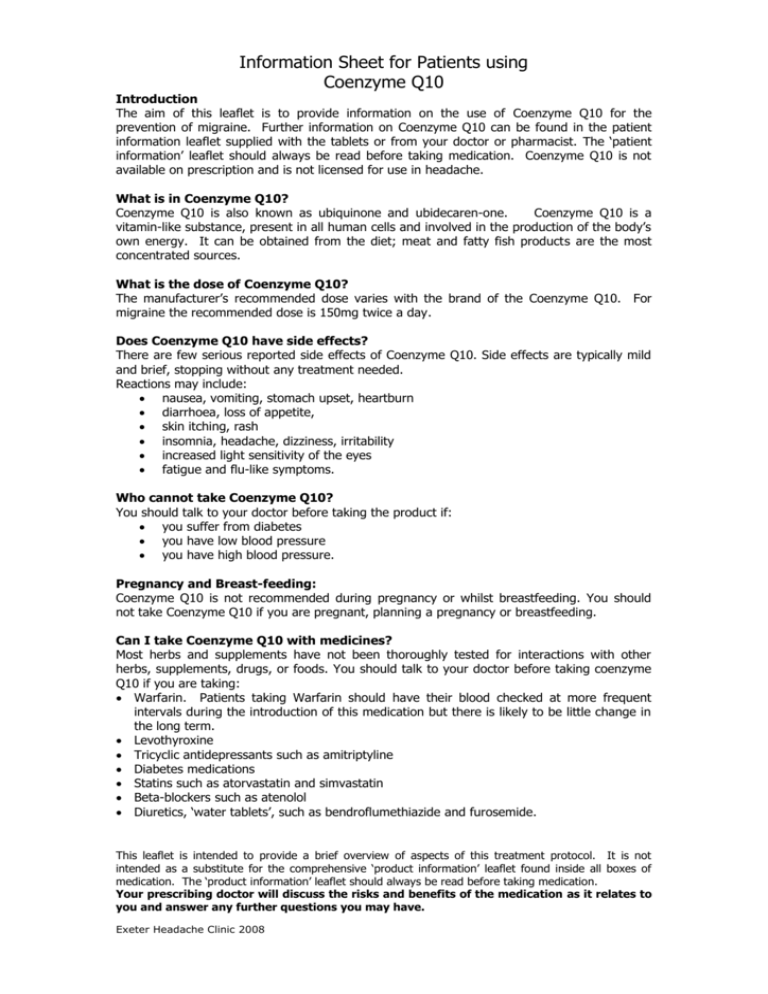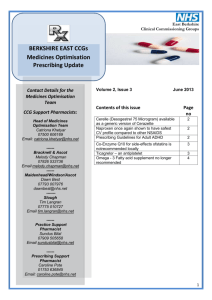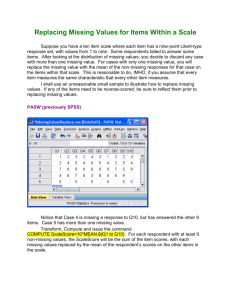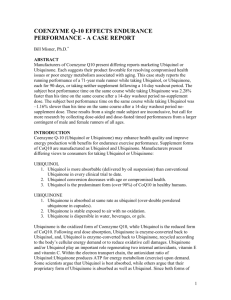Information sheet for Co-enzyme Q10
advertisement

Information Sheet for Patients using Coenzyme Q10 Introduction The aim of this leaflet is to provide information on the use of Coenzyme Q10 for the prevention of migraine. Further information on Coenzyme Q10 can be found in the patient information leaflet supplied with the tablets or from your doctor or pharmacist. The ‘patient information’ leaflet should always be read before taking medication. Coenzyme Q10 is not available on prescription and is not licensed for use in headache. What is in Coenzyme Q10? Coenzyme Q10 is also known as ubiquinone and ubidecaren-one. Coenzyme Q10 is a vitamin-like substance, present in all human cells and involved in the production of the body’s own energy. It can be obtained from the diet; meat and fatty fish products are the most concentrated sources. What is the dose of Coenzyme Q10? The manufacturer’s recommended dose varies with the brand of the Coenzyme Q10. For migraine the recommended dose is 150mg twice a day. Does Coenzyme Q10 have side effects? There are few serious reported side effects of Coenzyme Q10. Side effects are typically mild and brief, stopping without any treatment needed. Reactions may include: nausea, vomiting, stomach upset, heartburn diarrhoea, loss of appetite, skin itching, rash insomnia, headache, dizziness, irritability increased light sensitivity of the eyes fatigue and flu-like symptoms. Who cannot take Coenzyme Q10? You should talk to your doctor before taking the product if: you suffer from diabetes you have low blood pressure you have high blood pressure. Pregnancy and Breast-feeding: Coenzyme Q10 is not recommended during pregnancy or whilst breastfeeding. You should not take Coenzyme Q10 if you are pregnant, planning a pregnancy or breastfeeding. Can I take Coenzyme Q10 with medicines? Most herbs and supplements have not been thoroughly tested for interactions with other herbs, supplements, drugs, or foods. You should talk to your doctor before taking coenzyme Q10 if you are taking: Warfarin. Patients taking Warfarin should have their blood checked at more frequent intervals during the introduction of this medication but there is likely to be little change in the long term. Levothyroxine Tricyclic antidepressants such as amitriptyline Diabetes medications Statins such as atorvastatin and simvastatin Beta-blockers such as atenolol Diuretics, ‘water tablets’, such as bendroflumethiazide and furosemide. This leaflet is intended to provide a brief overview of aspects of this treatment protocol. It is not intended as a substitute for the comprehensive ‘product information’ leaflet found inside all boxes of medication. The ‘product information’ leaflet should always be read before taking medication. Your prescribing doctor will discuss the risks and benefits of the medication as it relates to you and answer any further questions you may have. Exeter Headache Clinic 2008







